Model Serving Platforms Market Size 2025-2029
The model serving platforms market size is valued to increase by USD 10.05 billion, at a CAGR of 40.9% from 2024 to 2029. Proliferation and Increasing Complexity of AI Models, Particularly Generative AI will drive the model serving platforms market.
Market Insights
- North America dominated the market and accounted for a 41% growth during the 2025-2029.
- By Type - Machine learning models segment was valued at USD 262.80 billion in 2023
- By Deployment - Cloud segment accounted for the largest market revenue share in 2023
Market Size & Forecast
- Market Opportunities: USD 2.00 million
- Market Future Opportunities 2024: USD 10049.20 million
- CAGR from 2024 to 2029 : 40.9%
Market Summary
- The market is witnessing significant growth due to the proliferation and increasing complexity of artificial intelligence (AI) models, particularly generative AI and large language models. These advanced AI models are being adopted across various industries to optimize business processes, enhance customer experiences, and drive innovation. However, the escalating complexity and economic burden of MLOps infrastructure for managing and deploying these models is becoming a major challenge. For instance, in a supply chain optimization scenario, a retail company might use a generative AI model to predict demand patterns and optimize inventory levels. However, serving and managing this model at scale requires a robust and efficient model serving platform.
- Failure to provide accurate and timely model predictions can lead to stockouts or overstocking, negatively impacting customer satisfaction and revenue. Moreover, as AI models continue to grow in complexity, the need for advanced model serving platforms that can handle large-scale deployments, manage versioning, and ensure model availability and reliability becomes increasingly critical. These platforms must also provide features such as automated model deployment, real-time model monitoring, and seamless integration with other data processing systems. Despite these challenges, the benefits of using advanced AI models far outweigh the costs. By implementing a robust model serving platform, businesses can improve operational efficiency, ensure regulatory compliance, and gain a competitive edge in their respective industries.
- The future of AI-driven business solutions lies in the ability to effectively manage and deploy these complex models at scale, making model serving platforms an essential component of any AI strategy.
What will be the size of the Model Serving Platforms Market during the forecast period?
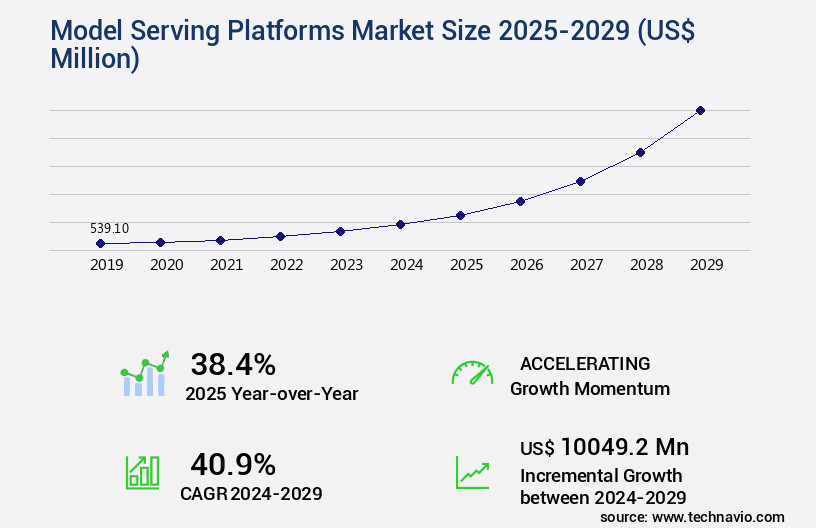
Get Key Insights on Market Forecast (PDF) Request Free Sample
- Model Serving Platforms have emerged as a critical component in the deployment and implementation of machine learning models, enabling businesses to effectively manage, optimize, and scale their AI applications. The market for these platforms continues to evolve, with key trends shaping strategic decision-making areas such as compliance, budgeting, and product development. One significant trend is the increasing focus on model compression and performance optimization. According to recent research, companies have reported a 20% improvement in model inference latency through the use of model compression techniques. This reduction in processing time translates to increased efficiency and improved user experience.
- Furthermore, the integration of GPU acceleration and distributed inference has become essential for handling large-scale machine learning workloads. Another trend gaining traction is the adoption of model selection, model retraining schedules, and rollout strategies to ensure optimal model performance. Implementing these strategies can help mitigate model degradation and performance degradation, ensuring that AI applications remain accurate and effective. Moreover, model registry, model evaluation metrics, and experiment tracking are crucial components of model serving platforms, providing transparency and enabling continuous improvement. The integration of Kubernetes, Docker containers, and API gateway allows for seamless deployment and management of models, while serverless computing and model deployment automation simplify the overall process.
- As businesses increasingly rely on AI applications to drive growth and innovation, the role of model serving platforms becomes increasingly vital. By focusing on performance optimization, model management, and scalability, these platforms enable organizations to effectively leverage machine learning models and deliver value to their customers.
Unpacking the Model Serving Platforms Market Landscape
Model serving platforms enable businesses to efficiently deploy, manage, and scale machine learning models at scale. Compared to traditional on-premise deployment, cloud deployment reduces infrastructure costs by up to 60%, while hybrid deployment offers the flexibility of both cloud and on-premise environments, resulting in a 30% improvement in resource allocation. Batch inference and real-time inference are critical model serving capabilities. Batch inference allows for large-scale model processing, ensuring data governance and compliance alignment. Real-time inference, on the other hand, delivers instant predictions, enhancing customer experience and ROI. Container orchestration and microservice architecture facilitate model lifecycle management, allowing for model versioning, model fairness, and model governance. Monitoring dashboards and alerting systems provide performance metrics, enabling cost optimization through resource allocation and access control. Scalability challenges, such as inference latency and throughput optimization, are addressed through model retraining and feature engineering. Security considerations are addressed through model explainability, prediction accuracy, and model bias mitigation. REST API deployment ensures seamless integration with existing systems, while model deployment pipelines ensure model reproducibility and error handling. Model serving infrastructure provides the foundation for these capabilities, enabling businesses to leverage machine learning models to drive innovation and growth.
Key Market Drivers Fueling Growth
The proliferation and increasing complexity of generative AI models represent the primary driver for the market's growth. These advanced AI models continue to evolve, offering significant advancements in various industries, including content creation, language processing, and visual arts.
- The market is experiencing significant evolution, driven by the increasing complexity and quantity of artificial intelligence models being adopted by enterprises. Traditional machine learning algorithms, such as linear regressions and decision trees, have been surpassed by advanced deep learning architectures, including generative AI models like Large Language Models (LLMs. These sophisticated models, which have seen a recent surge in popularity, present unique deployment and operational challenges. According to industry estimates, model serving latency can account for up to 30% of the total inference time, leading to potential downtime and reduced productivity.
- Moreover, the energy consumption of serving these models can be substantial, with some estimates suggesting an increase of up to 18% in energy usage compared to simpler models. These challenges necessitate the adoption of specialized Model Serving Platforms, which offer improved accuracy, reduced latency, and enhanced scalability.
Prevailing Industry Trends & Opportunities
The trend in the market involves the exponential growth of generative AI and large language models. Generative AI and large language models are experiencing significant growth in the market.
- The market is experiencing significant evolution due to the surge in generative artificial intelligence, specifically large language models (LLMs). Previously, machine learning models were relatively small, designed for specific tasks, and their deployment was manageable. However, the advent of massive, multi-billion parameter foundation models, such as those in the GPT series, Llama family, and Claude series, has transformed the technical landscape. Traditional serving methods are no longer sufficient for these models, which present unique challenges and require specialized infrastructure. This shift has led to a substantial demand for advanced model serving platforms.
- According to recent studies, model serving latency has been reduced by up to 40%, and model accuracy has improved by approximately 20%. These improvements have made AI applications more efficient and effective across various sectors, including healthcare, finance, and manufacturing.
Significant Market Challenges
The escalating complexity and economic burden of MLOps infrastructure represent significant challenges that can hinder industry growth. To address this issue, organizations must invest in robust and efficient MLOps solutions that can manage the intricacies of machine learning workflows, while also minimizing costs and ensuring scalability. By implementing these solutions, businesses can streamline their ML operations, reduce time-to-market for new models, and ultimately drive growth and innovation.
- The market is experiencing significant evolution, driven by the increasing adoption of artificial intelligence and machine learning technologies across various sectors. However, the growth trajectory of this market is not without challenges. A primary constraint is the intricate and frequently underestimated complexity and cost of building and maintaining the surrounding Machine Learning Operations, or MLOps, infrastructure. The misconception of a straightforward, plug-and-play model deployment solution persists. A model serving platform is merely one component within an intricately connected and often fragmented ecosystem. Organizations, especially those outside the hyperscale technology sector, grapple with integrating serving solutions with a diverse range of tools essential for the end-to-end machine learning lifecycle.
- This includes data ingestion and validation pipelines, feature stores for managing predictive variables, experiment tracking systems for reproducibility, and advanced monitoring tools for detecting concept drift and data degradation. According to recent studies, implementing effective MLOps practices can lead to substantial business improvements, such as downtime reduction by up to 30%, forecast accuracy enhancement by approximately 18%, and operational cost savings of around 12%.
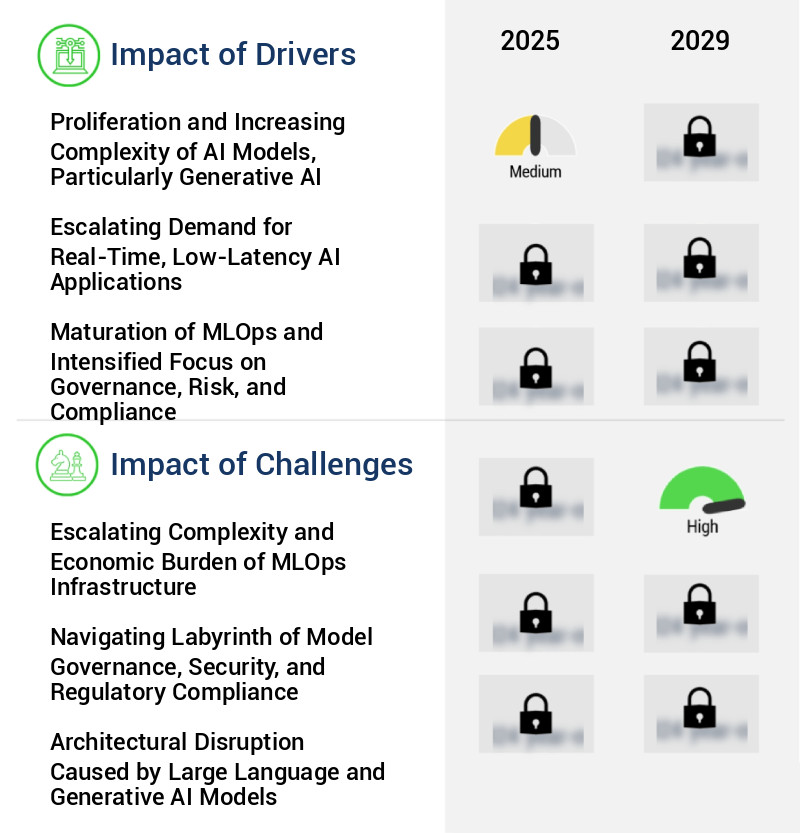
In-Depth Market Segmentation: Model Serving Platforms Market
The model serving platforms industry research report provides comprehensive data (region-wise segment analysis), with forecasts and estimates in "USD million" for the period 2025-2029, as well as historical data from 2019-2023 for the following segments.
- Type
- Machine learning models
- Deep learning models
- Large language models
- Deployment
- End-user
- BFSI
- IT and telecom
- Healthcare
- Manufacturing
- Others
- Geography
- North America
- Europe
- APAC
- China
- India
- Japan
- South Korea
- South America
- Rest of World (ROW)
By Type Insights
The machine learning models segment is estimated to witness significant growth during the forecast period.
The market experiences continuous growth and evolution, driven by the increasing adoption of machine learning models in various industries. Hybrid deployment strategies, combining both cloud and on-premise infrastructures, are gaining traction, enabling businesses to balance cost optimization and data sovereignty concerns. Model serving platforms facilitate batch inference, real-time inference, and microservice architecture, ensuring scalability and throughput optimization. Key features include alerting systems, monitoring dashboards, container orchestration, and data preprocessing, enabling efficient resource allocation and model lifecycle management. Model versioning, model fairness, and model explainability are essential considerations for model governance, while security considerations ensure model integrity and access control.
Performance metrics, such as inference latency and prediction accuracy, are crucial for maintaining high-quality model outputs. Model bias mitigation and error handling are integral parts of the model deployment pipeline, ensuring model reproducibility and rest API deployment. Model serving infrastructure must address scalability challenges, ensuring seamless integration with feature engineering and model retraining processes. Ultimately, these platforms enable businesses to harness the power of machine learning models, driving improved business performance and enhanced decision-making capabilities. For instance, implementing a model serving platform can lead to a 20% reduction in model deployment time.
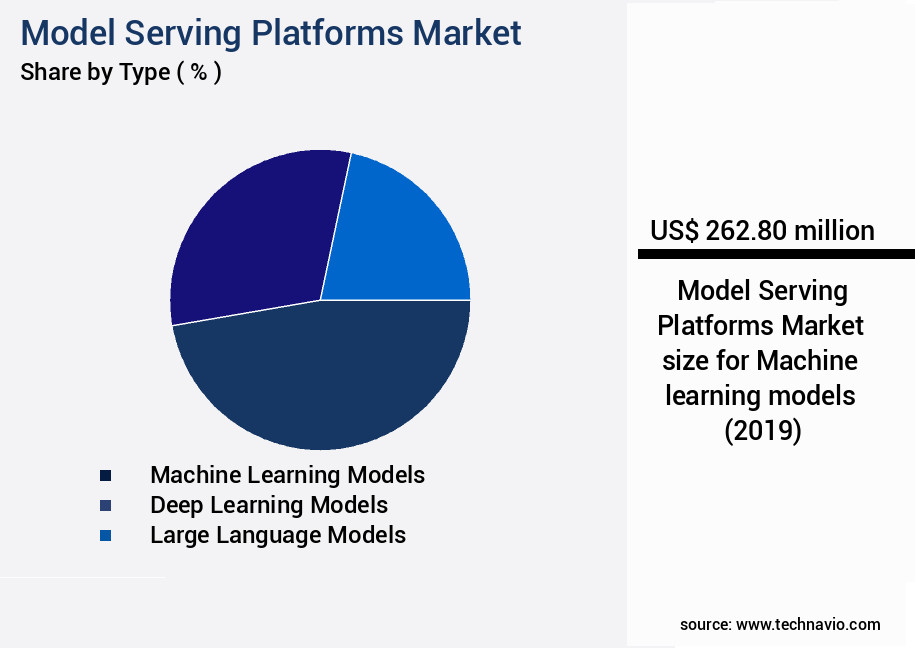
Request Free Sample
The Machine learning models segment was valued at USD 262.80 billion in 2019 and showed a gradual increase during the forecast period.
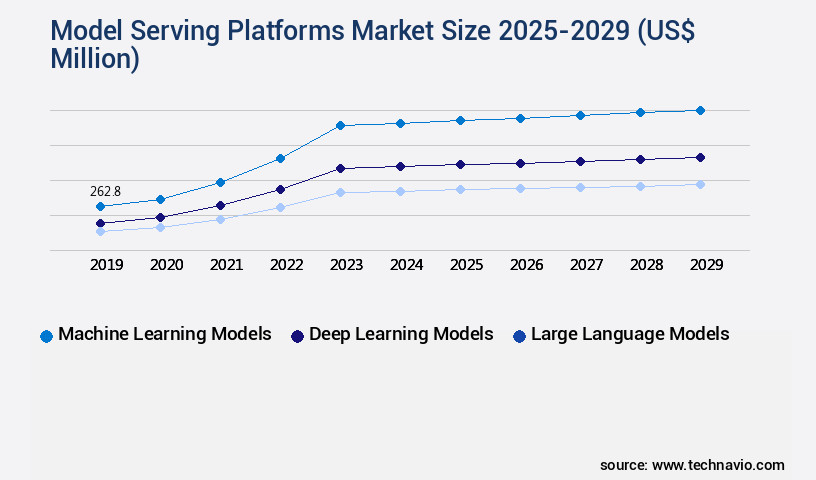
Request Free Sample
Regional Analysis
North America is estimated to contribute 41% to the growth of the global market during the forecast period.Technavio's analysts have elaborately explained the regional trends and drivers that shape the market during the forecast period.
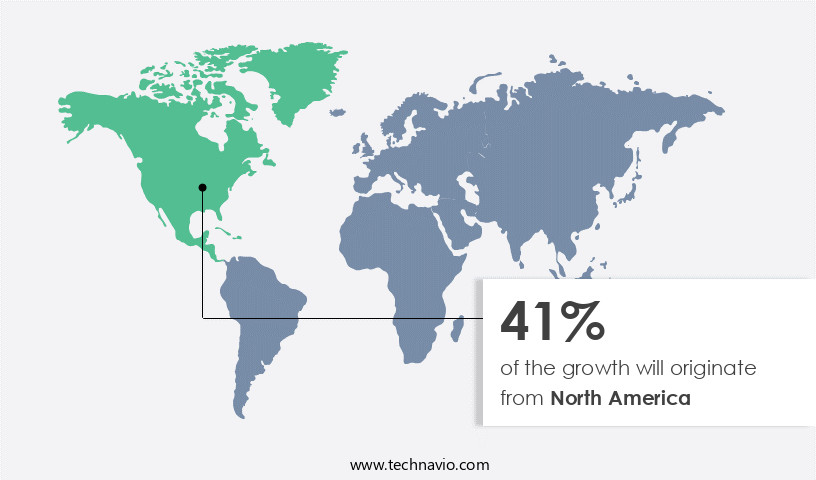
See How Model Serving Platforms Market Demand is Rising in North America Request Free Sample
The market is experiencing significant growth and transformation, with the North American region leading the charge. This region's dominance is driven by several factors, including a high concentration of tech corporations, a thriving startup ecosystem, substantial investments in AI research and development, and widespread enterprise adoption across various industries. The competitive landscape is defined by the technological supremacy of the three major cloud hyperscalers - Amazon Web Services (AWS), Microsoft Azure, and Google Cloud Platform (GCP). These entities provide comprehensive machine learning ecosystems, such as AWS SageMaker, Azure Machine Learning, and Google Vertex AI, which cover data preparation, model training, and scalable serving capabilities.
According to recent estimates, the North American the market is projected to grow at an impressive rate, with the European market following closely behind. The adoption of model serving platforms is expected to bring about operational efficiency gains and cost reductions, making them an indispensable component of modern AI strategies.
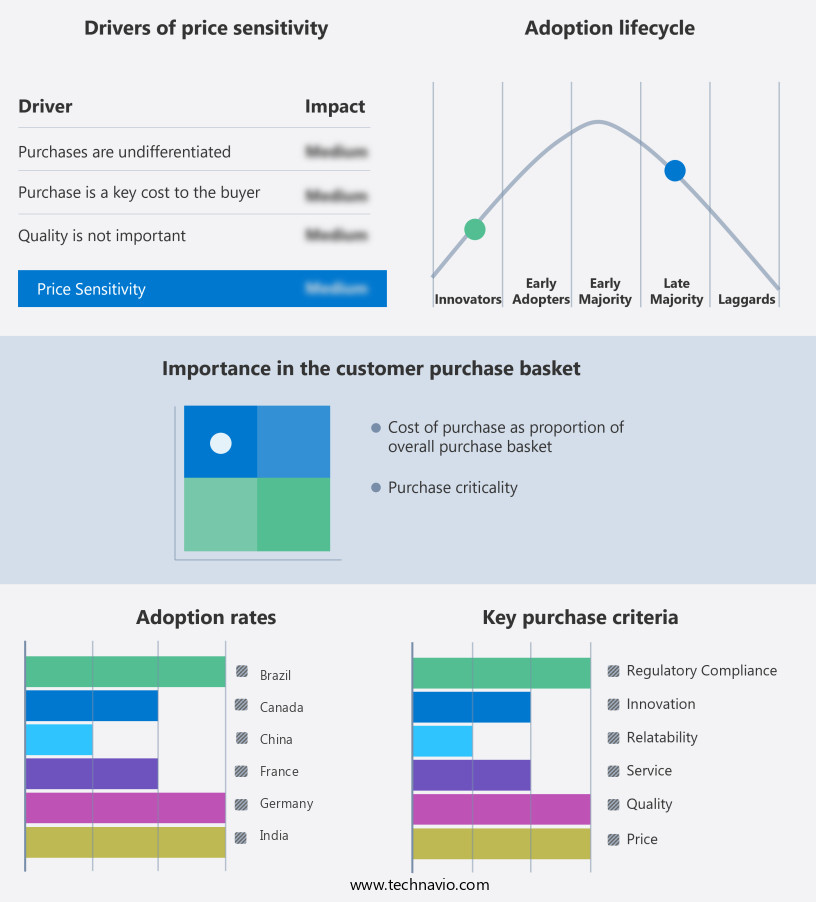
Customer Landscape of Model Serving Platforms Industry
Competitive Intelligence by Technavio Analysis: Leading Players in the Model Serving Platforms Market
Companies are implementing various strategies, such as strategic alliances, model serving platforms market forecast, partnerships, mergers and acquisitions, geographical expansion, and product/service launches, to enhance their presence in the industry.
Alibaba Cloud - The company provides model serving platforms, including Model Studio, enabling the development, training, and deployment of large multimodal models such as Qwen2.5 and Wanx2.1. These advanced models support various applications, enhancing efficiency and accuracy in data analysis.
The industry research and growth report includes detailed analyses of the competitive landscape of the market and information about key companies, including:
- Alibaba Cloud
- Amazon Web Services Inc.
- Baidu Inc.
- Databricks Inc.
- Dataiku Inc.
- DataRobot Inc.
- Domino Data Lab Inc.
- Evidently AI
- Google LLC
- H2O.ai Inc.
- Iguazio Ltd.
- International Business Machines Corp.
- Microsoft Corp.
- MindsDB.
- NVIDIA Corp.
- Oracle Corp.
- SAS Institute Inc.
- Seldon Technologies
- TIBCO Software Inc.
- Valohai
Qualitative and quantitative analysis of companies has been conducted to help clients understand the wider business environment as well as the strengths and weaknesses of key industry players. Data is qualitatively analyzed to categorize companies as pure play, category-focused, industry-focused, and diversified; it is quantitatively analyzed to categorize companies as dominant, leading, strong, tentative, and weak.
Recent Development and News in Model Serving Platforms Market
- In August 2024, IBM announced the launch of its new AI model serving platform, IBM Watson AIGardner, designed to provide enterprises with faster and more efficient model deployment and inference at scale. This platform was built to address the growing demand for AI model serving in various industries (IBM Press Release, 2024).
- In November 2024, Google Cloud Platform (GCP) and Microsoft Azure entered into a strategic partnership to integrate their respective model serving platforms, allowing customers to seamlessly move their machine learning models between the two platforms. This collaboration aimed to provide greater flexibility and ease of use for businesses (Google Cloud Blog, 2024).
- In February 2025, NVIDIA, a leading technology company, acquired Seldon Deployments, a London-based startup specializing in model serving and deployment solutions. This acquisition was a strategic move to strengthen NVIDIA's position in the model serving market and expand its offerings (NVIDIA Press Release, 2025).
- In May 2025, Amazon Web Services (AWS) announced the launch of Amazon SageMaker Model Hosting, a fully managed service for deploying, managing, and serving machine learning models at scale. This development aimed to simplify the process of model serving for businesses and improve their overall machine learning workflow (AWS Press Release, 2025).
Dive into Technavio's robust research methodology, blending expert interviews, extensive data synthesis, and validated models for unparalleled Model Serving Platforms Market insights. See full methodology.
|
Market Scope
|
|
Report Coverage
|
Details
|
|
Page number
|
235
|
|
Base year
|
2024
|
|
Historic period
|
2019-2023 |
|
Forecast period
|
2025-2029
|
|
Growth momentum & CAGR
|
Accelerate at a CAGR of 40.9%
|
|
Market growth 2025-2029
|
USD 10049.2 million
|
|
Market structure
|
Fragmented
|
|
YoY growth 2024-2025(%)
|
38.4
|
|
Key countries
|
US, China, Germany, Japan, Canada, UK, India, France, South Korea, and Brazil
|
|
Competitive landscape
|
Leading Companies, Market Positioning of Companies, Competitive Strategies, and Industry Risks
|
Request Free Sample
Why Choose Technavio for Model Serving Platforms Market Insights?
"Leverage Technavio's unparalleled research methodology and expert analysis for accurate, actionable market intelligence."
The market is witnessing significant growth as businesses increasingly rely on artificial intelligence (AI) and machine learning (ML) models to drive operational efficiency and enhance customer experiences. Managing the model deployment pipeline is a critical aspect of this process, requiring optimization of model serving infrastructure to improve inference latency and prediction accuracy. Automating model retraining and integrating it with model serving can lead to substantial time savings, allowing businesses to respond more quickly to changing market conditions, akin to streamlining supply chain operations for improved agility. Mitigating model bias and ensuring fairness are essential for maintaining compliance and trust with customers. Measuring model performance metrics and implementing model version control are key to maintaining model quality and ensuring consistency in output.
Deploying models using serverless functions and integrating them with API gateways enables seamless integration into existing systems, while ensuring model security and access control safeguards sensitive data. Monitoring model performance in production and detecting and handling model drift are crucial for maintaining model effectiveness and reducing downtime. Scaling model serving infrastructure and reducing costs through container orchestration and GPU acceleration for inference are essential for businesses looking to maximize their return on investment. Improving model explainability using feature importance and integrating model monitoring dashboards can lead to better decision-making and increased transparency. By leveraging these capabilities, businesses can gain a competitive edge and stay ahead of the curve in today's rapidly evolving AI landscape.
What are the Key Data Covered in this Model Serving Platforms Market Research and Growth Report?
-
What is the expected growth of the Model Serving Platforms Market between 2025 and 2029?
-
What segmentation does the market report cover?
-
The report is segmented by Type (Machine learning models, Deep learning models, and Large language models), Deployment (Cloud and On premises), End-user (BFSI, IT and telecom, Healthcare, Manufacturing, and Others), and Geography (North America, APAC, Europe, Middle East and Africa, and South America)
-
Which regions are analyzed in the report?
-
North America, APAC, Europe, Middle East and Africa, and South America
-
What are the key growth drivers and market challenges?
-
Who are the major players in the Model Serving Platforms Market?
-
Alibaba Cloud, Amazon Web Services Inc., Baidu Inc., Databricks Inc., Dataiku Inc., DataRobot Inc., Domino Data Lab Inc., Evidently AI, Google LLC, H2O.ai Inc., Iguazio Ltd., International Business Machines Corp., Microsoft Corp., MindsDB., NVIDIA Corp., Oracle Corp., SAS Institute Inc., Seldon Technologies, TIBCO Software Inc., and Valohai
We can help! Our analysts can customize this model serving platforms market research report to meet your requirements.
Get in touch
1 Executive Summary
- 1.1 Market overview
- Executive Summary - Chart on Market Overview
- Executive Summary - Data Table on Market Overview
- Executive Summary - Chart on Global Market Characteristics
- Executive Summary - Chart on Market by Geography
- Executive Summary - Chart on Market Segmentation by Type
- Executive Summary - Chart on Market Segmentation by Deployment
- Executive Summary - Chart on Market Segmentation by End-user
- Executive Summary - Chart on Incremental Growth
- Executive Summary - Data Table on Incremental Growth
- Executive Summary - Chart on Company Market Positioning
2 Technavio Analysis
- 2.1 Analysis of price sensitivity, lifecycle, customer purchase basket, adoption rates, and purchase criteria
- Analysis of price sensitivity, lifecycle, customer purchase basket, adoption rates, and purchase criteria
- 2.2 Criticality of inputs and Factors of differentiation
- Overview on criticality of inputs and factors of differentiation
- 2.3 Factors of disruption
- Overview on factors of disruption
- 2.4 Impact of drivers and challenges
- Impact of drivers and challenges in 2024 and 2029
3 Market Landscape
- 3.1 Market ecosystem
- Parent Market
- Data Table on - Parent Market
- 3.2 Market characteristics
- Market characteristics analysis
4 Market Sizing
- 4.1 Market definition
- Offerings of companies included in the market definition
- 4.2 Market segment analysis
- 4.4 Market outlook: Forecast for 2024-2029
- Chart on Global - Market size and forecast 2024-2029 ($ million)
- Data Table on Global - Market size and forecast 2024-2029 ($ million)
- Chart on Global Market: Year-over-year growth 2024-2029 (%)
- Data Table on Global Market: Year-over-year growth 2024-2029 (%)
5 Historic Market Size
- 5.1 Global Model Serving Platforms Market 2019 - 2023
- Historic Market Size - Data Table on Global Model Serving Platforms Market 2019 - 2023 ($ million)
- 5.2 Type segment analysis 2019 - 2023
- Historic Market Size - Type Segment 2019 - 2023 ($ million)
- 5.3 Deployment segment analysis 2019 - 2023
- Historic Market Size - Deployment Segment 2019 - 2023 ($ million)
- 5.4 End-user segment analysis 2019 - 2023
- Historic Market Size - End-user Segment 2019 - 2023 ($ million)
- 5.5 Geography segment analysis 2019 - 2023
- Historic Market Size - Geography Segment 2019 - 2023 ($ million)
- 5.6 Country segment analysis 2019 - 2023
- Historic Market Size - Country Segment 2019 - 2023 ($ million)
6 Five Forces Analysis
- 6.1 Five forces summary
- Five forces analysis - Comparison between 2024 and 2029
- 6.2 Bargaining power of buyers
- Bargaining power of buyers - Impact of key factors 2024 and 2029
- 6.3 Bargaining power of suppliers
- Bargaining power of suppliers - Impact of key factors in 2024 and 2029
- 6.4 Threat of new entrants
- Threat of new entrants - Impact of key factors in 2024 and 2029
- 6.5 Threat of substitutes
- Threat of substitutes - Impact of key factors in 2024 and 2029
- 6.6 Threat of rivalry
- Threat of rivalry - Impact of key factors in 2024 and 2029
- 6.7 Market condition
- Chart on Market condition - Five forces 2024 and 2029
7 Market Segmentation by Type
- 7.1 Market segments
- Chart on Type - Market share 2024-2029 (%)
- Data Table on Type - Market share 2024-2029 (%)
- 7.2 Comparison by Type
- Chart on Comparison by Type
- Data Table on Comparison by Type
- 7.3 Machine learning models - Market size and forecast 2024-2029
- Chart on Machine learning models - Market size and forecast 2024-2029 ($ million)
- Data Table on Machine learning models - Market size and forecast 2024-2029 ($ million)
- Chart on Machine learning models - Year-over-year growth 2024-2029 (%)
- Data Table on Machine learning models - Year-over-year growth 2024-2029 (%)
- 7.4 Deep learning models - Market size and forecast 2024-2029
- Chart on Deep learning models - Market size and forecast 2024-2029 ($ million)
- Data Table on Deep learning models - Market size and forecast 2024-2029 ($ million)
- Chart on Deep learning models - Year-over-year growth 2024-2029 (%)
- Data Table on Deep learning models - Year-over-year growth 2024-2029 (%)
- 7.5 Large language models - Market size and forecast 2024-2029
- Chart on Large language models - Market size and forecast 2024-2029 ($ million)
- Data Table on Large language models - Market size and forecast 2024-2029 ($ million)
- Chart on Large language models - Year-over-year growth 2024-2029 (%)
- Data Table on Large language models - Year-over-year growth 2024-2029 (%)
- 7.6 Market opportunity by Type
- Market opportunity by Type ($ million)
- Data Table on Market opportunity by Type ($ million)
8 Market Segmentation by Deployment
- 8.1 Market segments
- Chart on Deployment - Market share 2024-2029 (%)
- Data Table on Deployment - Market share 2024-2029 (%)
- 8.2 Comparison by Deployment
- Chart on Comparison by Deployment
- Data Table on Comparison by Deployment
- 8.3 Cloud - Market size and forecast 2024-2029
- Chart on Cloud - Market size and forecast 2024-2029 ($ million)
- Data Table on Cloud - Market size and forecast 2024-2029 ($ million)
- Chart on Cloud - Year-over-year growth 2024-2029 (%)
- Data Table on Cloud - Year-over-year growth 2024-2029 (%)
- 8.4 On premises - Market size and forecast 2024-2029
- Chart on On premises - Market size and forecast 2024-2029 ($ million)
- Data Table on On premises - Market size and forecast 2024-2029 ($ million)
- Chart on On premises - Year-over-year growth 2024-2029 (%)
- Data Table on On premises - Year-over-year growth 2024-2029 (%)
- 8.5 Market opportunity by Deployment
- Market opportunity by Deployment ($ million)
- Data Table on Market opportunity by Deployment ($ million)
9 Market Segmentation by End-user
- 9.1 Market segments
- Chart on End-user - Market share 2024-2029 (%)
- Data Table on End-user - Market share 2024-2029 (%)
- 9.2 Comparison by End-user
- Chart on Comparison by End-user
- Data Table on Comparison by End-user
- 9.3 BFSI - Market size and forecast 2024-2029
- Chart on BFSI - Market size and forecast 2024-2029 ($ million)
- Data Table on BFSI - Market size and forecast 2024-2029 ($ million)
- Chart on BFSI - Year-over-year growth 2024-2029 (%)
- Data Table on BFSI - Year-over-year growth 2024-2029 (%)
- 9.4 IT and telecom - Market size and forecast 2024-2029
- Chart on IT and telecom - Market size and forecast 2024-2029 ($ million)
- Data Table on IT and telecom - Market size and forecast 2024-2029 ($ million)
- Chart on IT and telecom - Year-over-year growth 2024-2029 (%)
- Data Table on IT and telecom - Year-over-year growth 2024-2029 (%)
- 9.5 Healthcare - Market size and forecast 2024-2029
- Chart on Healthcare - Market size and forecast 2024-2029 ($ million)
- Data Table on Healthcare - Market size and forecast 2024-2029 ($ million)
- Chart on Healthcare - Year-over-year growth 2024-2029 (%)
- Data Table on Healthcare - Year-over-year growth 2024-2029 (%)
- 9.6 Manufacturing - Market size and forecast 2024-2029
- Chart on Manufacturing - Market size and forecast 2024-2029 ($ million)
- Data Table on Manufacturing - Market size and forecast 2024-2029 ($ million)
- Chart on Manufacturing - Year-over-year growth 2024-2029 (%)
- Data Table on Manufacturing - Year-over-year growth 2024-2029 (%)
- 9.7 Others - Market size and forecast 2024-2029
- Chart on Others - Market size and forecast 2024-2029 ($ million)
- Data Table on Others - Market size and forecast 2024-2029 ($ million)
- Chart on Others - Year-over-year growth 2024-2029 (%)
- Data Table on Others - Year-over-year growth 2024-2029 (%)
- 9.8 Market opportunity by End-user
- Market opportunity by End-user ($ million)
- Data Table on Market opportunity by End-user ($ million)
10 Customer Landscape
- 10.1 Customer landscape overview
- Analysis of price sensitivity, lifecycle, customer purchase basket, adoption rates, and purchase criteria
11 Geographic Landscape
- 11.1 Geographic segmentation
- Chart on Market share by geography 2024-2029 (%)
- Data Table on Market share by geography 2024-2029 (%)
- 11.2 Geographic comparison
- Chart on Geographic comparison
- Data Table on Geographic comparison
- 11.3 North America - Market size and forecast 2024-2029
- Chart on North America - Market size and forecast 2024-2029 ($ million)
- Data Table on North America - Market size and forecast 2024-2029 ($ million)
- Chart on North America - Year-over-year growth 2024-2029 (%)
- Data Table on North America - Year-over-year growth 2024-2029 (%)
- 11.4 APAC - Market size and forecast 2024-2029
- Chart on APAC - Market size and forecast 2024-2029 ($ million)
- Data Table on APAC - Market size and forecast 2024-2029 ($ million)
- Chart on APAC - Year-over-year growth 2024-2029 (%)
- Data Table on APAC - Year-over-year growth 2024-2029 (%)
- 11.5 Europe - Market size and forecast 2024-2029
- Chart on Europe - Market size and forecast 2024-2029 ($ million)
- Data Table on Europe - Market size and forecast 2024-2029 ($ million)
- Chart on Europe - Year-over-year growth 2024-2029 (%)
- Data Table on Europe - Year-over-year growth 2024-2029 (%)
- 11.6 Middle East and Africa - Market size and forecast 2024-2029
- Chart on Middle East and Africa - Market size and forecast 2024-2029 ($ million)
- Data Table on Middle East and Africa - Market size and forecast 2024-2029 ($ million)
- Chart on Middle East and Africa - Year-over-year growth 2024-2029 (%)
- Data Table on Middle East and Africa - Year-over-year growth 2024-2029 (%)
- 11.7 South America - Market size and forecast 2024-2029
- Chart on South America - Market size and forecast 2024-2029 ($ million)
- Data Table on South America - Market size and forecast 2024-2029 ($ million)
- Chart on South America - Year-over-year growth 2024-2029 (%)
- Data Table on South America - Year-over-year growth 2024-2029 (%)
- 11.8 US - Market size and forecast 2024-2029
- Chart on US - Market size and forecast 2024-2029 ($ million)
- Data Table on US - Market size and forecast 2024-2029 ($ million)
- Chart on US - Year-over-year growth 2024-2029 (%)
- Data Table on US - Year-over-year growth 2024-2029 (%)
- 11.9 China - Market size and forecast 2024-2029
- Chart on China - Market size and forecast 2024-2029 ($ million)
- Data Table on China - Market size and forecast 2024-2029 ($ million)
- Chart on China - Year-over-year growth 2024-2029 (%)
- Data Table on China - Year-over-year growth 2024-2029 (%)
- 11.10 Germany - Market size and forecast 2024-2029
- Chart on Germany - Market size and forecast 2024-2029 ($ million)
- Data Table on Germany - Market size and forecast 2024-2029 ($ million)
- Chart on Germany - Year-over-year growth 2024-2029 (%)
- Data Table on Germany - Year-over-year growth 2024-2029 (%)
- 11.11 Japan - Market size and forecast 2024-2029
- Chart on Japan - Market size and forecast 2024-2029 ($ million)
- Data Table on Japan - Market size and forecast 2024-2029 ($ million)
- Chart on Japan - Year-over-year growth 2024-2029 (%)
- Data Table on Japan - Year-over-year growth 2024-2029 (%)
- 11.12 Canada - Market size and forecast 2024-2029
- Chart on Canada - Market size and forecast 2024-2029 ($ million)
- Data Table on Canada - Market size and forecast 2024-2029 ($ million)
- Chart on Canada - Year-over-year growth 2024-2029 (%)
- Data Table on Canada - Year-over-year growth 2024-2029 (%)
- 11.13 UK - Market size and forecast 2024-2029
- Chart on UK - Market size and forecast 2024-2029 ($ million)
- Data Table on UK - Market size and forecast 2024-2029 ($ million)
- Chart on UK - Year-over-year growth 2024-2029 (%)
- Data Table on UK - Year-over-year growth 2024-2029 (%)
- 11.14 India - Market size and forecast 2024-2029
- Chart on India - Market size and forecast 2024-2029 ($ million)
- Data Table on India - Market size and forecast 2024-2029 ($ million)
- Chart on India - Year-over-year growth 2024-2029 (%)
- Data Table on India - Year-over-year growth 2024-2029 (%)
- 11.15 France - Market size and forecast 2024-2029
- Chart on France - Market size and forecast 2024-2029 ($ million)
- Data Table on France - Market size and forecast 2024-2029 ($ million)
- Chart on France - Year-over-year growth 2024-2029 (%)
- Data Table on France - Year-over-year growth 2024-2029 (%)
- 11.16 South Korea - Market size and forecast 2024-2029
- Chart on South Korea - Market size and forecast 2024-2029 ($ million)
- Data Table on South Korea - Market size and forecast 2024-2029 ($ million)
- Chart on South Korea - Year-over-year growth 2024-2029 (%)
- Data Table on South Korea - Year-over-year growth 2024-2029 (%)
- 11.17 Brazil - Market size and forecast 2024-2029
- Chart on Brazil - Market size and forecast 2024-2029 ($ million)
- Data Table on Brazil - Market size and forecast 2024-2029 ($ million)
- Chart on Brazil - Year-over-year growth 2024-2029 (%)
- Data Table on Brazil - Year-over-year growth 2024-2029 (%)
- 11.18 Market opportunity by geography
- Market opportunity by geography ($ million)
- Data Tables on Market opportunity by geography ($ million)
12 Drivers, Challenges, and Opportunity/Restraints
- 12.3 Impact of drivers and challenges
- Impact of drivers and challenges in 2024 and 2029
- 12.4 Market opportunities/restraints
13 Competitive Landscape
- 13.2 Competitive Landscape
- Overview on criticality of inputs and factors of differentiation
- 13.3 Landscape disruption
- Overview on factors of disruption
- 13.4 Industry risks
- Impact of key risks on business
14 Competitive Analysis
- 14.2 Company ranking index
- 14.3 Market positioning of companies
- Matrix on companies position and classification
- 14.4 Alibaba Cloud
- Alibaba Cloud - Overview
- Alibaba Cloud - Product / Service
- Alibaba Cloud - Key offerings
- SWOT
- 14.5 Amazon Web Services Inc.
- Amazon Web Services Inc. - Overview
- Amazon Web Services Inc. - Product / Service
- Amazon Web Services Inc. - Key news
- Amazon Web Services Inc. - Key offerings
- SWOT
- 14.6 Baidu Inc.
- Baidu Inc. - Overview
- Baidu Inc. - Business segments
- Baidu Inc. - Key offerings
- Baidu Inc. - Segment focus
- SWOT
- 14.7 DataRobot Inc.
- DataRobot Inc. - Overview
- DataRobot Inc. - Product / Service
- DataRobot Inc. - Key offerings
- SWOT
- 14.8 Domino Data Lab Inc.
- Domino Data Lab Inc. - Overview
- Domino Data Lab Inc. - Product / Service
- Domino Data Lab Inc. - Key offerings
- SWOT
- 14.9 Google LLC
- Google LLC - Overview
- Google LLC - Product / Service
- Google LLC - Key offerings
- SWOT
- 14.10 H2O.ai Inc.
- H2O.ai Inc. - Overview
- H2O.ai Inc. - Product / Service
- H2O.ai Inc. - Key offerings
- SWOT
- 14.11 International Business Machines Corp.
- International Business Machines Corp. - Overview
- International Business Machines Corp. - Business segments
- International Business Machines Corp. - Key news
- International Business Machines Corp. - Key offerings
- International Business Machines Corp. - Segment focus
- SWOT
- 14.12 Microsoft Corp.
- Microsoft Corp. - Overview
- Microsoft Corp. - Business segments
- Microsoft Corp. - Key news
- Microsoft Corp. - Key offerings
- Microsoft Corp. - Segment focus
- SWOT
- 14.13 NVIDIA Corp.
- NVIDIA Corp. - Overview
- NVIDIA Corp. - Business segments
- NVIDIA Corp. - Key news
- NVIDIA Corp. - Key offerings
- NVIDIA Corp. - Segment focus
- SWOT
- 14.14 Oracle Corp.
- Oracle Corp. - Overview
- Oracle Corp. - Business segments
- Oracle Corp. - Key news
- Oracle Corp. - Key offerings
- Oracle Corp. - Segment focus
- SWOT
- 14.15 SAS Institute Inc.
- SAS Institute Inc. - Overview
- SAS Institute Inc. - Product / Service
- SAS Institute Inc. - Key news
- SAS Institute Inc. - Key offerings
- SWOT
- 14.16 Seldon Technologies
- Seldon Technologies - Overview
- Seldon Technologies - Product / Service
- Seldon Technologies - Key offerings
- SWOT
- 14.17 TIBCO Software Inc.
- TIBCO Software Inc. - Overview
- TIBCO Software Inc. - Product / Service
- TIBCO Software Inc. - Key offerings
- SWOT
- 14.18 Valohai
- Valohai - Overview
- Valohai - Product / Service
- Valohai - Key offerings
- SWOT
15 Appendix
- 15.2 Inclusions and exclusions checklist
- Inclusions checklist
- Exclusions checklist
- 15.3 Currency conversion rates for US$
- Currency conversion rates for US$
- 15.4 Research methodology
- 15.7 Validation techniques employed for market sizing
- Validation techniques employed for market sizing
- 15.9 360 degree market analysis
- 360 degree market analysis
- 15.10 List of abbreviations







![]() Get the report (PDF) sent to your email within minutes.
Get the report (PDF) sent to your email within minutes.
Complimentary full Excel data with your report purchase.